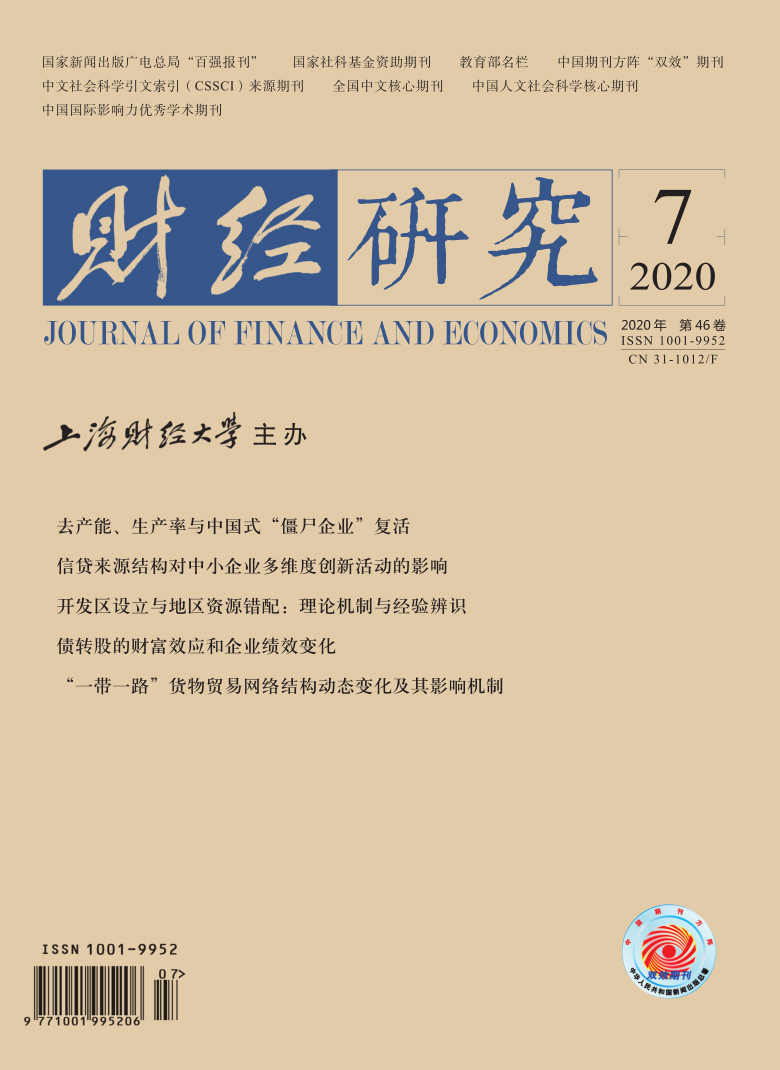员工持股计划(ESOP)作为一种企业发展的内部激励方式和分配形式在美国得到了广泛关注和充分运用;而员工持股计划是否适应中国国情,是否在本质上与我国的社会主义性质相吻合,这都需要进一步的理论说明和实证检验。文章基于员工持股计划的集体激励本质特性,从累积性、吸入性和异质性三个层面,构建了一个员工持股计划作用于企业创新的理论框架,并利用2007−2017年沪深两市相关上市公司的样本数据进行实证检验,结果表明:在我国,员工持股计划具有显著的创新激励效果,但对企业的创新影响并不是线性增加,而是呈现出“U”形的累积效应关系。进一步的讨论发现,员工持股计划对于创新性劳动的吸引力比较显著,且其创新激励效应在国有企业和高新技术企业中比较显著。文章对于如何推进员工持股计划在我国企业的创新实践中加以应用,以及如何落实社会主义基本分配制度的有效实现具有重要的政策启示。
员工持股计划、集体激励与企业创新
摘要
参考文献
6 孔锦,徐永翃. 员工持股计划激励作用的实证研究−基于陕西省非上市中小企业的历史数据[J]. 广西大学学报(哲学社会科学版),2015,(2):68−74. DOI:10.3969/j.issn.1001-8182.2015.02.012
7 廖红伟,杨良平. 国有企业改革中的员工持股制度分析−基于交易成本理论的视角[J]. 江汉论坛,2017,(9):24−29. DOI:10.3969/j.issn.1003-854X.2017.09.003
8 列宁. 列宁全集[M]. 北京: 人民出版社, 1963.
9 马克思, 恩格斯. 马克思恩格斯全集(第46卷上)[M]. 中央编译局编译. 北京: 人民出版社, 1979.
10 孟庆斌,李昕宇,张鹏. 员工持股计划能够促进企业创新吗?−基于企业员工视角的经验证据[J]. 管理世界,2019,(11):209−228. DOI:10.3969/j.issn.1002-5502.2019.11.016
11 [美]威廉·拉让尼克. 创新魔咒——新经济能否带来持续繁荣[M]. 黄一义, 冀书鹏译. 上海: 上海远东出版社, 2011.
13 温军,冯根福. 异质机构、企业性质与自主创新[J]. 经济研究,2012,(3):53−64. DOI:10.3969/j.issn.1002-5863.2012.03.024
14 周冬华,黄佳,赵玉洁. 员工持股计划与企业创新[J]. 会计研究,2019,(3):63−70. DOI:10.3969/j.issn.1003-2886.2019.03.009
15 Arqué-Castells P. How venture capitalists spur invention in Spain:Evidence from patent trajectories[J]. Research Policy,2012,41(5): 897−912. DOI:10.1016/j.respol.2012.01.008
17 Balkin D B,Markman G D,Gomez-Mejia L R. Is CEO pay in high-technology firms related to innovation?[J]. The Academy of Management Journal,2000,43(6): 1118−1129. DOI:10.5465/1556340
19 Conyon M,Gregg P,Machin S. Taking care of business:Executive compensation in the united kingdom[J]. The Economic Journal,1995,105(430): 704−714. DOI:10.2307/2235029
20 Cornaggia J,Mao Y F,Tian X,et al. Does banking competition affect innovation?[J]. Journal of Financial Economics,2015,115(1): 189−209. DOI:10.1016/j.jfineco.2014.09.001
21 Garret R. Does employee ownership increase innovation?[J]. New England Journal of Entrepreneurship,2010,13(2): 37−46. DOI:10.1108/NEJE-13-02-2010-B003
22 Gomez-Mejia L R, Balkin D B. Compensation, organizational strategy, and firm performance[M]. Cincinnati, O H: South-Western Publishing, 1992.
23 Hall B J,Liebman J B. Are CEOs really paid like bureaucrats?[J]. The Quarterly Journal of Economics,1998,113(3): 653−691. DOI:10.1162/003355398555702
24 Hall B J,Murphy K J. The trouble with stock options[J]. The Journal of Economic Perspectives,2003,17(3): 49−70. DOI:10.1257/089533003769204353
25 Hallock D E,Salazar R J,Venneman S. Demographic and attitudinal correlates of employee satisfaction with an ESOP[J]. British Journal of Management,2004,15(4): 321−333. DOI:10.1111/j.1467-8551.2004.00422.x
26 Heckman J. Sample selection bias as a specification error[J]. Econometrica,1979,47(1): 153−161. DOI:10.2307/1912352
27 Hirshleifer D,Hsu P H,Li D M. Innovative efficiency and stock returns[J]. Journal of Financial Economics,2013,107(3): 632−654. DOI:10.1016/j.jfineco.2012.09.011
28 Hsu P H,Tian X,Xu Y. Financial development and innovation:Cross-country evidence[J]. Journal of Financial Economics,2014,112(1): 116−135. DOI:10.1016/j.jfineco.2013.12.002
29 Jensen M C,Meckling W H. Theory of the firm:Managerial behavior,agency costs and ownership structure[J]. Journal of Financial Economics,1976,3(4): 305−360. DOI:10.1016/0304-405X(76)90026-X
31 Kumar R,Sopariwala P R. The effect of adoption of long-term performance plans on stock prices and accounting numbers[J]. Journal of Financial and Quantitative Analysis,1992,27(4): 561−573. DOI:10.2307/2331140
32 Kumbhakar S C,Dunbar A E. The elusive ESOP-productivity link:Evidence from U.S. firm-level data[J]. Journal of Public Economics,1993,52(2): 273−283. DOI:10.1016/0047-2727(93)90024-N
33 Lerner J,Wulf J. Innovation and incentives:Evidence from corporate R&D[J]. The Review of Economics and Statis- tics,2007,89(4): 634−644. DOI:10.1162/rest.89.4.634
34 Mehran H. Executive compensation structure,ownership and firm performance[J]. Journal of Financial Economics,1995,38(2): 163−184. DOI:10.1016/0304-405X(94)00809-F
35 Murphy K J. Executive compensation: Handbook of labor economics[M]. North-Holland: Amsterdam, 1999.
36 Robinson A M,Wilson N. Employee financial participation and productivity:An empirical reappraisal[J]. British Journal of Industrial Relations,2006,44(1): 31−50. DOI:10.1111/j.1467-8543.2006.00486.x
37 Rothaermel F T,Hess A M. Building dynamic capabilities:Innovation driven by individual-,firm-,and network-level effects[J]. Organization Science,2007,18(6): 885−1027. DOI:10.1287/orsc.1070.0337
38 Rousseau D M,Shperling Z. Pieces of the action:Ownership and the changing employment relationship[J]. The Academy of Management Review,2003,28(4): 553−570. DOI:10.5465/amr.2003.10899368
39 Sengupta S,Whitfield K,McNabb B. Employee share ownership and performance:Golden path or golden handcuffs?[J]. The International Journal of Human Resource Management,2007,18(8): 1507−1538. DOI:10.1080/09585190701502620
40 Schultz T. Investing in people: The economics of population quality[M]. Berkeley: University of California Press, 1981.
41 Schumpeter J A. Business cycles[M]. New York: McGraw Hill, 1939.
42 Wu J F,Tu R T. CEO stock option pay and R&D spending:A behavioral agency explanation[J]. Journal of Business Research,2007,60(5): 482−492. DOI:10.1016/j.jbusres.2006.12.006
44 Yoshio Y,Victor C. Creating incentives for innovation? The relationship between pay dispersion in R&D groups and firm innovation performance[J]. Strategic Management Journal,2013,34(12): 1502−1511. DOI:10.1002/smj.2071
45 Zahra S A,Neubaum D O,Huse M. Entrepreneurship in medium-size companies:Exploring the effects of ownership and governance systems[J]. Journal of Management,2000,26(5): 947−976. DOI:10.1177/014920630002600509
引用本文
李韵, 丁林峰. 员工持股计划、集体激励与企业创新[J]. 财经研究, 2020, 46(7): 35-48.
导出参考文献,格式为:
上一篇:共同机构所有权与企业产能利用率*





 6446
6446  6502
6502

